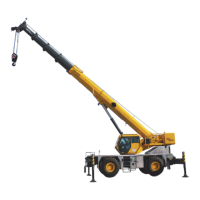4-2
Published 01-29-2014, Control # 496-00
BOOM TMS800E SERVICE MANUAL
DESCRIPTION
One boom is available on the crane; a four section, full
power, sequenced and synchronized, boom (see Figure 4-
1). The boom assembly utilizes a mega form design. The
boom utilizes two sequenced telescope cylinders for
telescoping and retracting of the boom plus cable
synchronization for the extension and retraction of the tele 3
section. Boom lift is provided by a single lift cylinder and
boom elevation is from - 3 degrees to +78 degrees.
Lattice Extension
10m - 17m (33ft - 56ft) offsettable bifold lattice swingaway
extension. Offsets 0°, 20°, and 40°. Stows alongside base
boom section.
Optional Lattice Extension
6.1m (20ft) lattice extension inserts install between the boom
nose and bifold extension are non-stowable. A standard
auxiliary boom nose (rooster sheave) is available for the
boom to simplify single part cable usage. The rooster sheave
is installed on the main boom nose and is secured by pins
that pass through the rooster sheave and main boom nose.
THEORY OF OPERATION
Extension
Extension and retraction is accomplished with two telescope
cylinders, four extension cables, and two retraction cables.
The lower telescope cylinder rod is secured to the rear of the
boom base section and the barrel is secured to tele 1 boom
section by a trunnion. The upper telescope cylinder rod is
secured to the rear of tele 1 boom section and the barrel is
secured to tele 2 boom section by a trunnion. The extension
cables are secured to the back of the tele 3 section and run
around extension sheaves on the cylinder mounted tele 3
sheave mount to the cable anchor at the lower cylinder.
The hydraulic fluid in both lower and upper telescope
cylinders is routed through the rods so that the barrels can
extend. There are two cam operated check valves which
control flow to the telescope cylinders. With both cylinders
retracted, the check valve for the lower telescope cylinder is
open and the check valve for the upper cylinder is closed
allowing the lower cylinder to extend. When the lower
cylinder is fully extended, the check valve for the upper
cylinder opens allowing the upper cylinder to extend. The
check valve for the lower cylinder closes after the upper
cylinder starts to extend and shuts off the flow to the lower
cylinder. As the upper telescope cylinder barrel extends, the
extend cables around the extend sheaves push on the
extend cables to pull the tele 3 section out at the same time
tele 2 is extending.
Boom Retraction
The upper telescope cylinder retracts the tele 2 and two
retract cables pull the tele 3 section in at the same time.
When the upper cylinder is fully retracted, the check valve for
the lower telescope cylinder is opened and the lower cylinder
starts to retract. The check valve for the upper cylinder is
closed as the lower cylinder starts to retract. Tele 2 and tele 3
retract first and then tele 1.
MAINTENANCE
Removal
NOTE: The boom weighs approximately 9570 kg (21098
lb). Removal of the swingaway jib will simplify
boom removal, therefore, the above weight is for
the boom without the swingaway jib attached.
1. Extend and set the outriggers to level the crane and
ensure the boom is fully retracted and in a horizontal
position over the front of the crane.
2. If equipped, remove the swingaway jib and auxiliary
nose according to the removal procedures in this
section.
3. Remove the hook block or headache ball and wind all
the wire rope onto the hoist drum.
4. Position the boom to make sure that the lift cylinder is
properly supported.
5. Attach a lifting device to the boom to provide for equal
weight distribution.
6. Tag and disconnect any electrical wiring from the boom.
7. Tag and disconnect the hydraulic lines to the lower
telescope cylinder.
CAUTION
Wear gloves when handling wire rope.
DANGER
Ensure the lifting device is capable of supporting the
boom assembly.
DANGER
Ensure the boom lift cylinder is properly supported before
disconnecting it from the boom.
Reference Only

